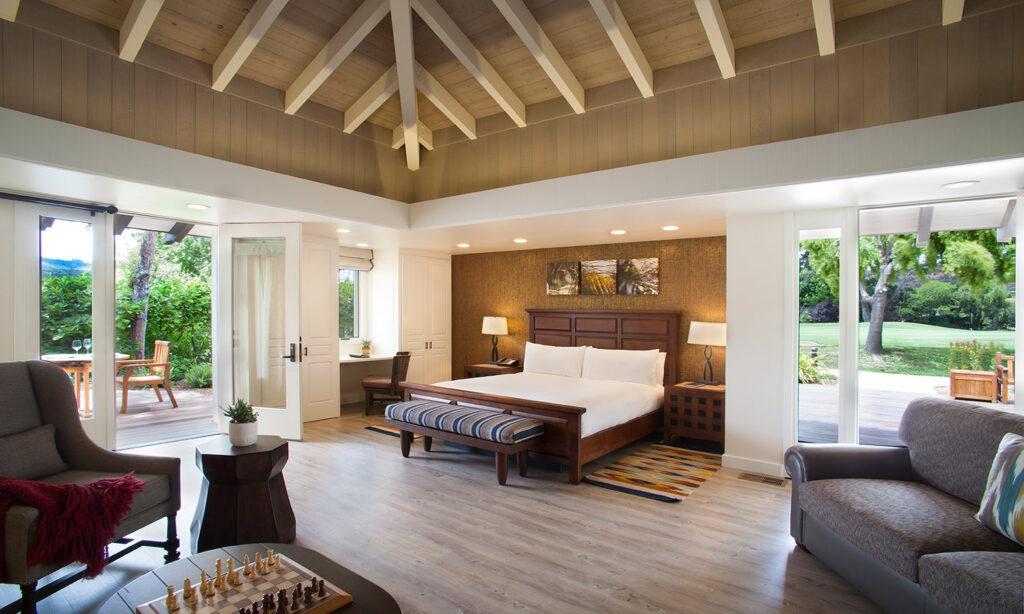EXAMINING THE ECONOMICS OF RESIDENCE HOTEL DEVELOPMENT
June 29, 2015

Image: AXIS designed Quail Lodge Executive Villa, AXIS Architecture + Design archives.
Earlier this week AXIS’ Twitter feed included a tweet linking to an article in Forbes Magazine pondering the boom in “residence hotel” development. Residence hotels – which blur the line between condominiums and hotels to the point where by all appearances residents are effectively living in a hotel – take many forms: from residential buildings simply providing amenities, staffs, and services indistinguishable from those found in today’s luxury hotels, to mixed-use buildings where residential units are peppered throughout an actual hotel. As you’d expect, hotel-styled living doesn’t come cheap, with the majority of hotel residences available only in the luxury residential segment, fetching multiple millions of dollars each, and in most cases, aligned only with the industry’s most posh luxury hotel brands.
Hotel residences are also a frequently more common investment vehicle; it’s estimated the Four Seasons brand rolls out nearly 40 residence suites for every 100 hotel rooms they build, and in Dubai – one of the most active real estate markets for Asian investors – it’s estimated that nearly 60% of all condo developments are of the residence hotel type. For architects, designers, builders, and investors, the growth in the residence hotel segment is clearly something to take seriously.
Coincidentally, the Forbes article was timely; at the recent NYU International Hospitality Industry Investment Conference – a conference I attended earlier this June and which I wrote about in a previous blog post – the notion of hotel residences was frequently discussed. Given AXIS Architecture + Design’s notability in the hospitality design and mixed-use architectural space, I found myself seeking sessions where the topic of hotel residences received a bit more focus, always curious what might explain the increase in demand for these types of luxury units. To explain that curiosity, it might be helpful to give a bit of context on this year’s NYU Hospitality event; one of the most prolific themes throughout the event was the notion that select service hotels – hotels that provide fewer amenities in favor of lower operating costs and ultimately lower room rates – were the investment of choice this year. It was even suggested that “European Footprint” rooms – rooms with fewer than 200 square feet of space – were likely to start to become common as the select service trend gained momentum. As I’m sure you can imagine, discussing in one session simple and austere select service hotels as an ideal investment, then in the next session having luxury hotel residences suggested as the investment of choice made me curious enough to want to discover what was driving these seemingly at odds strategies.
And what, according to NYU Hospitality’s panels and speakers, was driving the demand for hotel residences despite the increasing prominence of select service hotels? Quite simply, hotel developers of each of these project types are serving vastly different end user groups and investors. The condo-hotel developer is mostly targeting offshore high-net worth individuals seeking a safe haven for their investment capital. These are hotels in name only. For developers, hotel residences are much more about creating “exclusive” enclaves with all of the amenities of a five or six star resort. These projects are not driven by RevPAR, and can obviously net the savvy developer a very tidy return on investment if offered for sale during an economic upswing. It should be noted that as an investment, they are not for the faint of heart; many condo-hotel projects were left unfinished during the 2009 downturn. Conversely, select service hotels are much less capital intensive and can be undertaken with a corresponding reduction in risk. Wall Street has recognized this class of hotel as a solid investment, and they are often sold to REITs upon completion, which operate them more for ongoing cash flow than for their saleability.
Cory Creath is a Principal Architect at AXIS Architecture + Design, and regular speaker at hospitality industry trade shows and events. An expert on hospitality and hotel architecture, Cory’s comments will appears regularly here in On The AXIS, AXIS Architecture + Design’s official blog and sounding board.